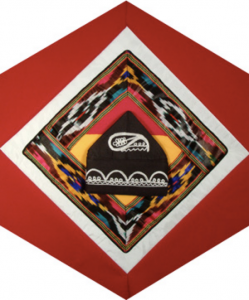Uzbekistan

The Block
This block features two of Uzbekistan’s highly respected arts: embroidery and weaving, both of which have been influenced by the customs of China and Western Europe. The block was crafted using textiles contributed by Ruslan Takhautdinov. In the centre is a traditional black, cotton skullcap embroidered in white. The four-sided dopy or tubeteika is an integral part of the Uzbek national costume, but is worn in modern daily life as well. It has been folded here in the same manner it would be for easy carrying. The cap is framed by colourful bands of silk ikat weaving. This centuries-old technique is a time-consuming process that involves creating designs in fabric by resist-dyeing the threads before the cloth is woven.
The silk production, which reflects Uzbekistanis’ love of bright colours, is called arbrandi in Uzbekistan. Legend has it that the name, which translated means ‘cloud’s reflection caught in silk,’ was given to the work of a master weaver. He had created the piece after seeing a rainbow of colours in the reflection of clouds upon the water’s surface.
Cultural Profile
Uzbekistan, a republic of the former Soviet Union, is one of central Asia’s most populated nations. Its varied landscape includes mountainous regions, arid steppe land and desert, as well as fertile areas and fast-flowing rivers. Uzbekistan is completely surrounded by landlocked nations, making it one of the only two double-landlocked countries in the world, the other being Liechtenstein. Despite this distinction, Uzbekistan has been involved in international trade for thousands of years. Several of its ancient cities, including Samarqand, the ‘most precious pearl in the world,’ and Tashkent, the ‘city of fountains,’ are located along the famed ‘Silk Road’ trading route that linked China and Western Europe. The population is comprised of many different ethnic groups. Uzbeks constitute about 80 percent of the inhabitants with Russians making up a large minority group. Uzbek is the official state language, although most ethnic minorities tend to speak their own native tongues. Russian, which was the preferred language during the Soviet period, is still widely used in the cities.
Uzbekistan is a major producer of gold and natural gas. It is also one of the world’s leading producers and exporters of cotton, which is known as ‘white gold.’ Karakul sheep are raised here and their tightly curled wool or astrakhan is used to make men’s traditional coats and hats. Uzbeks are among Central Asia’s most traditional people and many still dress in traditional attire on a daily basis. Green tea is offered automatically to any visitor, as hospitality is an important value in Uzbek culture.
Folk arts have been passed down for many generations and have a prominent place within the country’s cultural heritage. They include the ancient skill of ornamental wall painting, copperware, wood work ornamented with intricate paintings and lacquer work, carpet weaving, ceramics, leather work, silk spinning and ornamental and gold embroidery. The country is particularly renowned for suzani, a traditional style of embroidery which often forms part of a woman’s dowry and is still used extensively to decorate the home. Motifs of flowers, fruits, vines and birds are used extensively in Uzbek art, as well as geometric designs.
The classical, traditional music of Uzbekistan is the shashmaqam, meaning the ‘six maqams’, the six melodic modes of traditional Arabic music. The singing is accompanied by long-neck lutes and tambourines and traditional texts are about love for the divine.
People have been coming to Canada from Uzbekistan as an individual country since 1992 and there are currently just over 2,700 Uzbeks now living here.
Sponsor: Dr. Theo and Mrs. Diane Jaggassar
